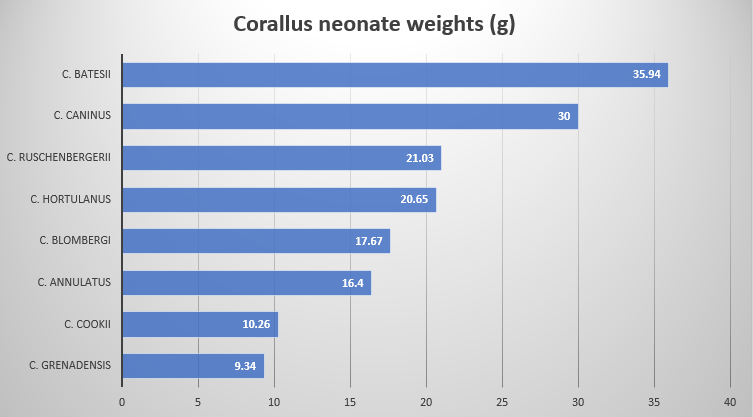The Genus Tropidophis was long considered to be a member of the Boa Superfamily, due to morphological similarities with this group. This view is also also reflected in their common name: Dwarf Boas. However, the positioning of these snakes within the boidae has been a matter of debate. See e.g.
Continue reading Notes on Tropidophis
A quick note on Corallus neonate weight comparisons
Corallus ruschenbergerii: documenting its life cycle in captivity
Of the 9 species in the genus Corallus, C. ruschenbergerii (Cope, 1875) is one of three species least understood. Two litters of insular C. ruschenbergerii were born on 14 November and 15 November, 2021. Litter sizes were 12 live/one stillborn and 13 live respectively. Neither litter contained any unfertilized ovum.
Average neonate weight for the first litter is 16.20 grams. All neonates were patterned in various shades of orange. All neonates underwent their first shed from days 9 through 13 after birth.
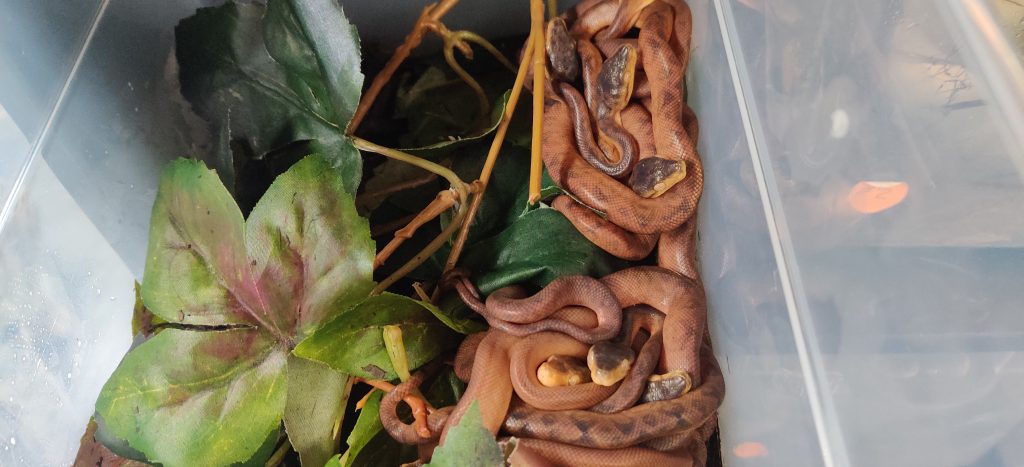
Average neonate weight for the 2nd litter is 17.19 grams. All neonates underwent their first shed from days 9 through 13 after birth. All neonates were patterned. Interestingly, two different color forms were present in this litter: nine newborns displayed various shades of orange and 4 were gray. This is the first time color heterogeneity is reported in an insular C. ruschenbergerii litter.
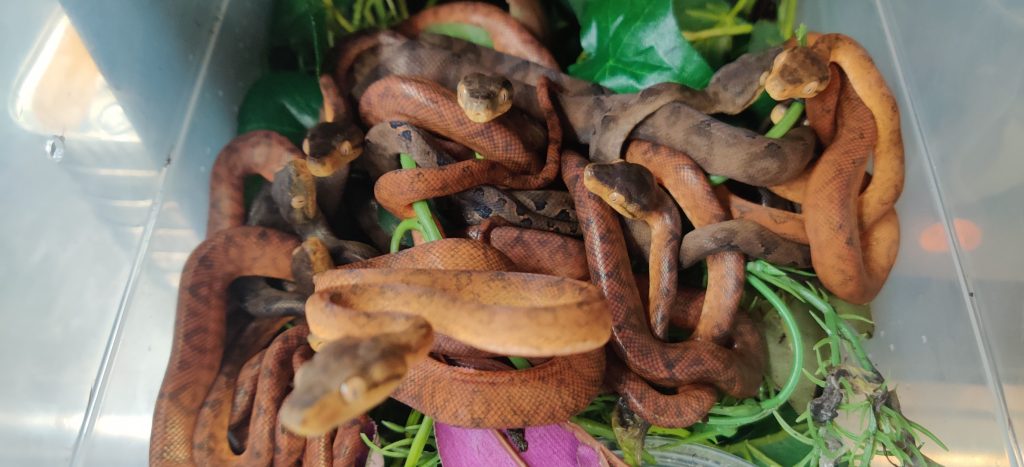
Compare these two litters with one litter born last year that consisted of all patternless neonates with the same shade of orange.
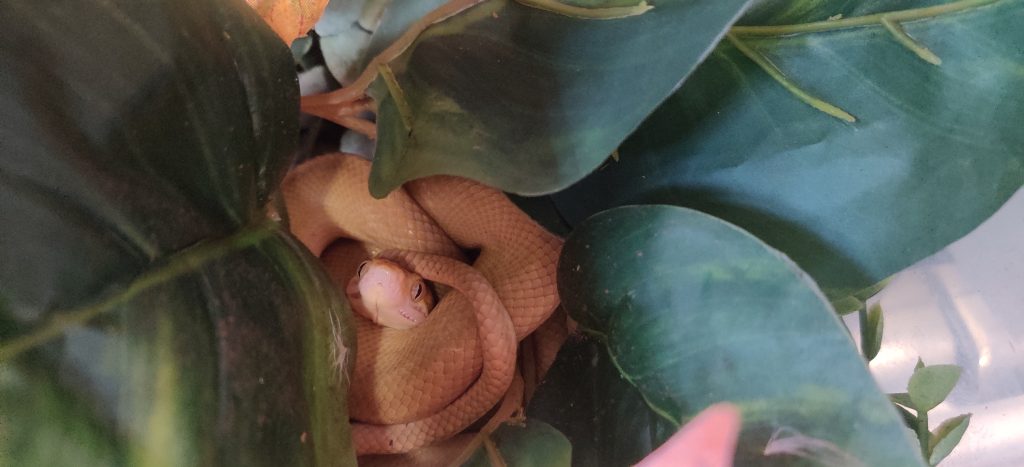
For more information and photos, visit the chapter on C. ruschenbergerii here.
Reptiles and Amphibians, Vol 28, No. 3, December 2021 issue
This particular issue has four articles on the Genus Tropidophis. They are:
Giant dwarfs: Very large giant tropes Tropidophis melanurus (Squamata: Tropidophiidae), and new maximum size records for the species.
https://journals.ku.edu/reptilesandamphibians/article/view/15965
New prey records for two snakes of the genus Tropidophis (Tropidophiidae) from urban habitats in La Habana, Cuba.
https://journals.ku.edu/reptilesandamphibians/article/view/15858
Predation on murid rodents by the Giant Trope, Tropidophis melanurus (Squamata: Tropidophiidae), with comments on predation of mammals by snakes of the genus Tropidophis
https://journals.ku.edu/reptilesandamphibians/article/view/15876
Westernmost record of the Spotted Red Trope, Tropidophis maculatus (Squamata: Tropidophiidae), with comments on the Tropidophis species assemblage from the Guanahacabibes Peninsula.
https://journals.ku.edu/reptilesandamphibians/article/view/15857
Individual PDF’s can be downloaded from each link.
Quote of the Month
Sir David Attenborough’s speech is a reminder to do whatever it takes to stop man made climate change and create a better world for today’s young generations.
Towards the end of his speech, he says:
"In my lifetime, I've witnessed a terrible decline, in yours, you could and should witness a wonderful recovery. That desperate hope, ladies and gentlemen, delegates excellency"
Breeding the endangered Jamaican Boa, Chilabothrus subflavus
Jamaican Boas have been bred as a measure of conservation since the 1970s. Today the species is still listed as Vulnerable (VU) by IUCN and listed in Appendix I of the Convention on International Trade in Endangered Species of Wild Fauna and Flora (CITES). The species is currently kept by multiple zoos and aquaria as well as private breeders. We sum up the annual breedings of this boa that we are aware of. Westindianboas.org provided over the years several breeders with breeding stock animals in the US. Unfortunately, restrictions make the export of this species unnecessarily difficult. Considering the good breeding successes on both sides of the Atlantic, it should be in the interest of conservation to exchange genetic material and thus continue to maintain a diverse genetic foundation for conservation.
Several litters of the Jamaican Boa, Chilabothrus subflavus, were born this season in the US, the UK and the EU. This particular litter, shown below, was born 9 September, 2021. Produced by Rob Stone of the US, the litter numbered 17 live with no stillborn or unfertilized ovum. Neonate weights ranged from 10.83 g to 13.93 g, with a mean of 12.98 g. SVL of the neonates was 25.72 cm to 33.18 cm, with a mean of 30.13 cm.
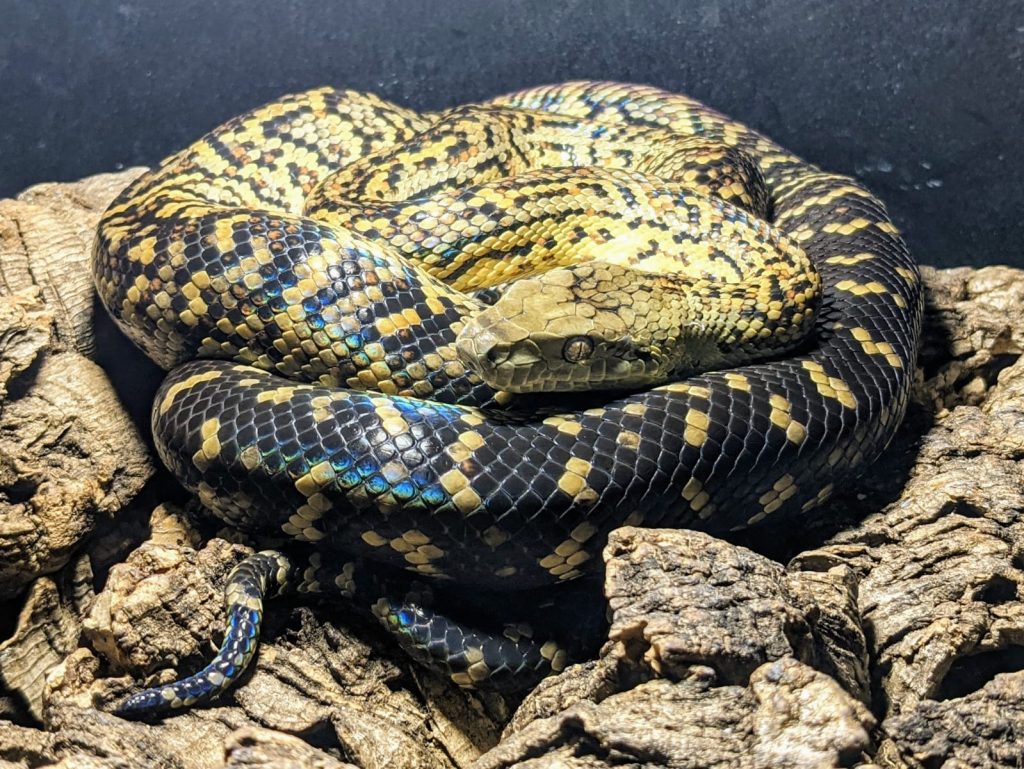
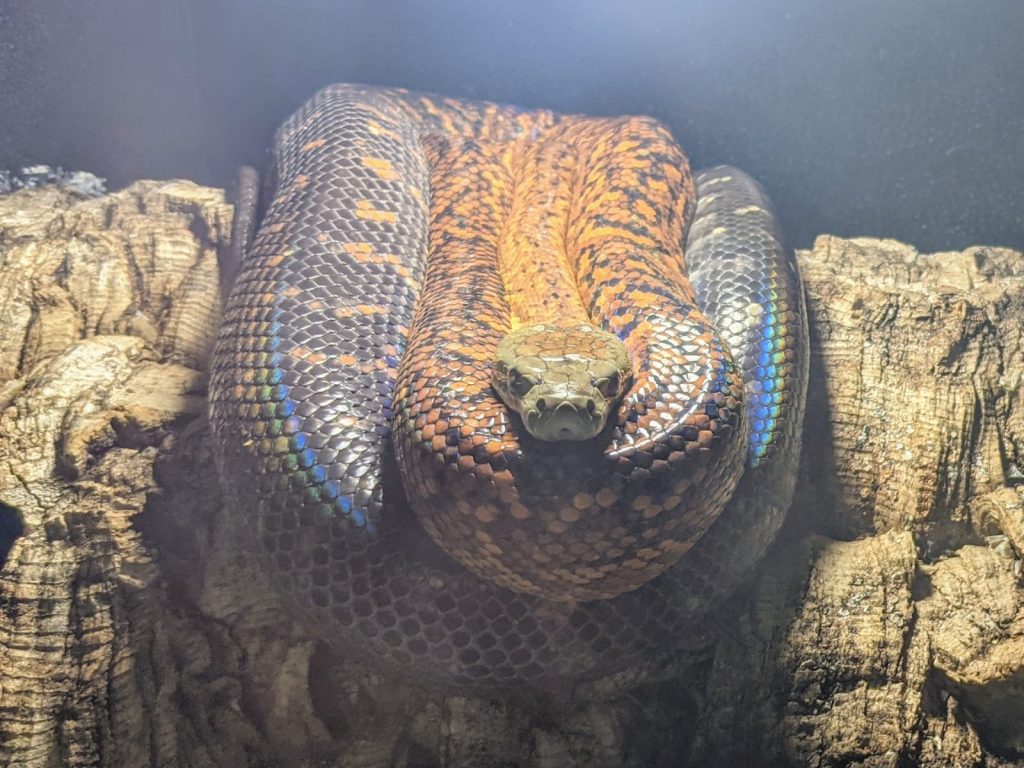
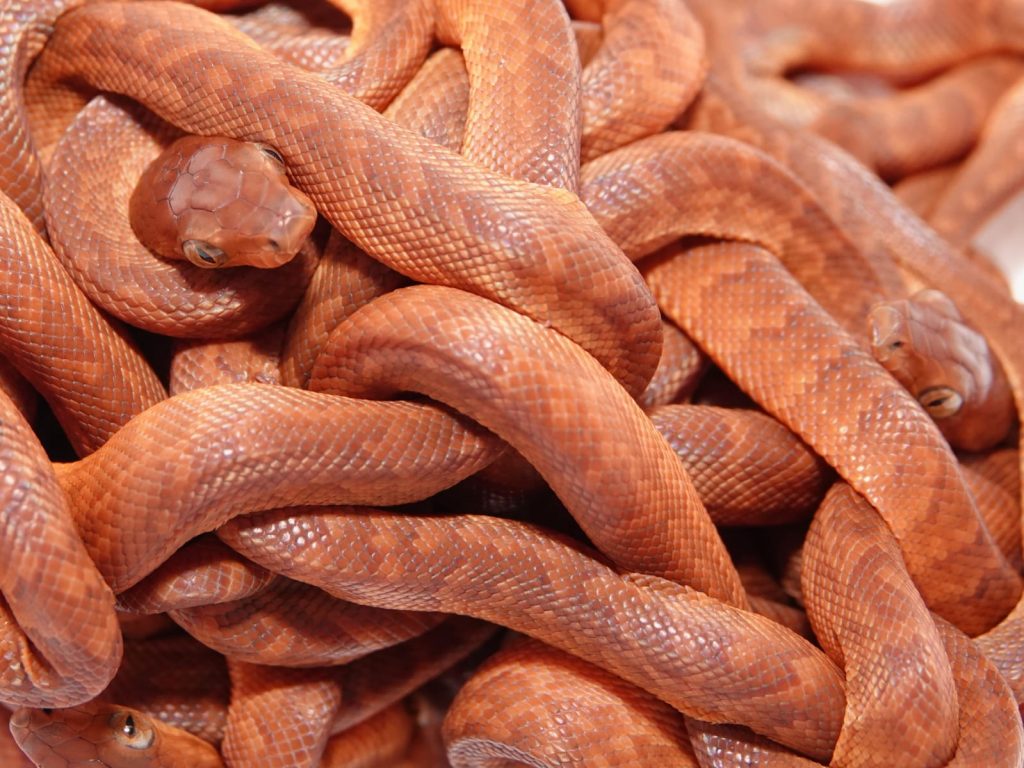
The Jamaican Boa is highly variable in color and pattern; the ontogenetic color change will take 18 – 24 months to complete.
The following litters were also produced during the 2021 season:
- UK: 12 live, 2 stillborn and 7 unfertilized ova on 3 October, 2021. Bred by Tom Middlebrook and Faye Da Costa.
- US: 15 live, 1 unfertilized ovum on 27 September, 2021. Bred by David Muth and Jared Rager.
- US: 34 live, 3 stillborn and 3 or 4 unfertilized ova on 26 September, 2021. Bred by Tom Crutchfield.
- Germany: 9 live, 1 stillborn and 6 unfertilized ova on 14 September, 2021. Bred by Sebastian Hölch.
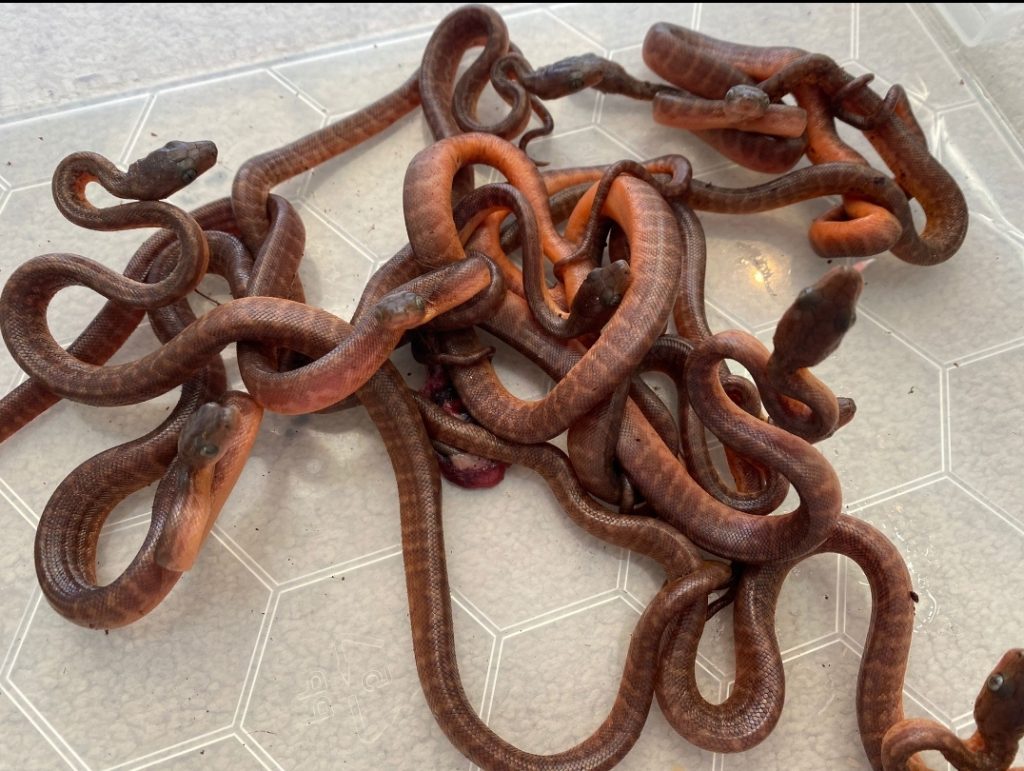
Visit the chapter for the Jamaican Boa here for more in depth information and photos.
Chilabothrus neonate season continues with Bahamas Boas
The Bahamas Boa Chilabothrus s. strigilatus is a species that relatively few private persons keep and, to our knowledge, no zoo worldwide has these fascinating boas on display. We are more than pleased to announce that a litter of C. strigilatus was born on October 1st in Germany.
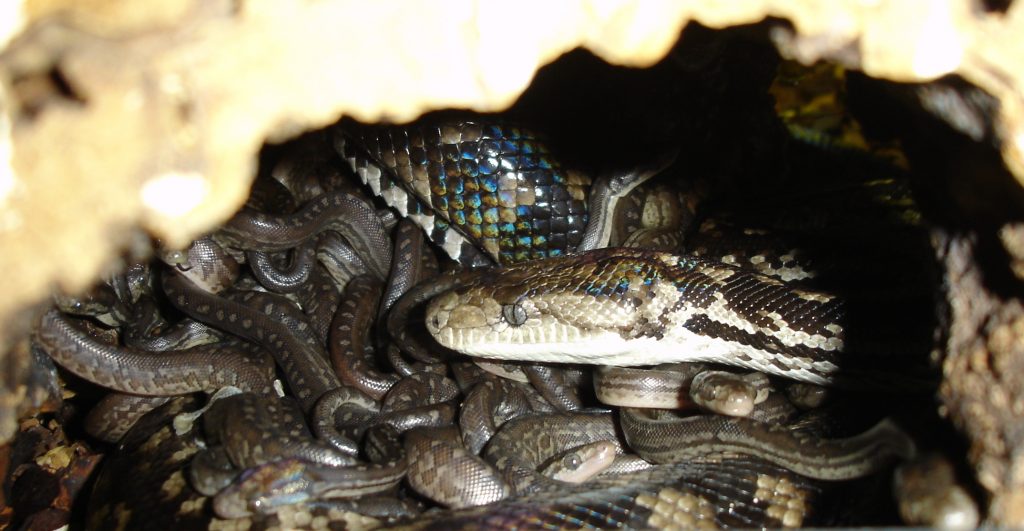
Birth began in the morning hours from 8.30am. The moon phase was in between half and new moon. The pressure system was high and the morning was sunny, however, in the evening a low pressure system came in and it started to rain.
The post ovulation shed of the female boa occurred on June 13th, thus 110 days passed between post ovulation shed and birth. Noticeably, the yolk was entirely used up in all babies and only the allantois was present as extraembryonic tissue.
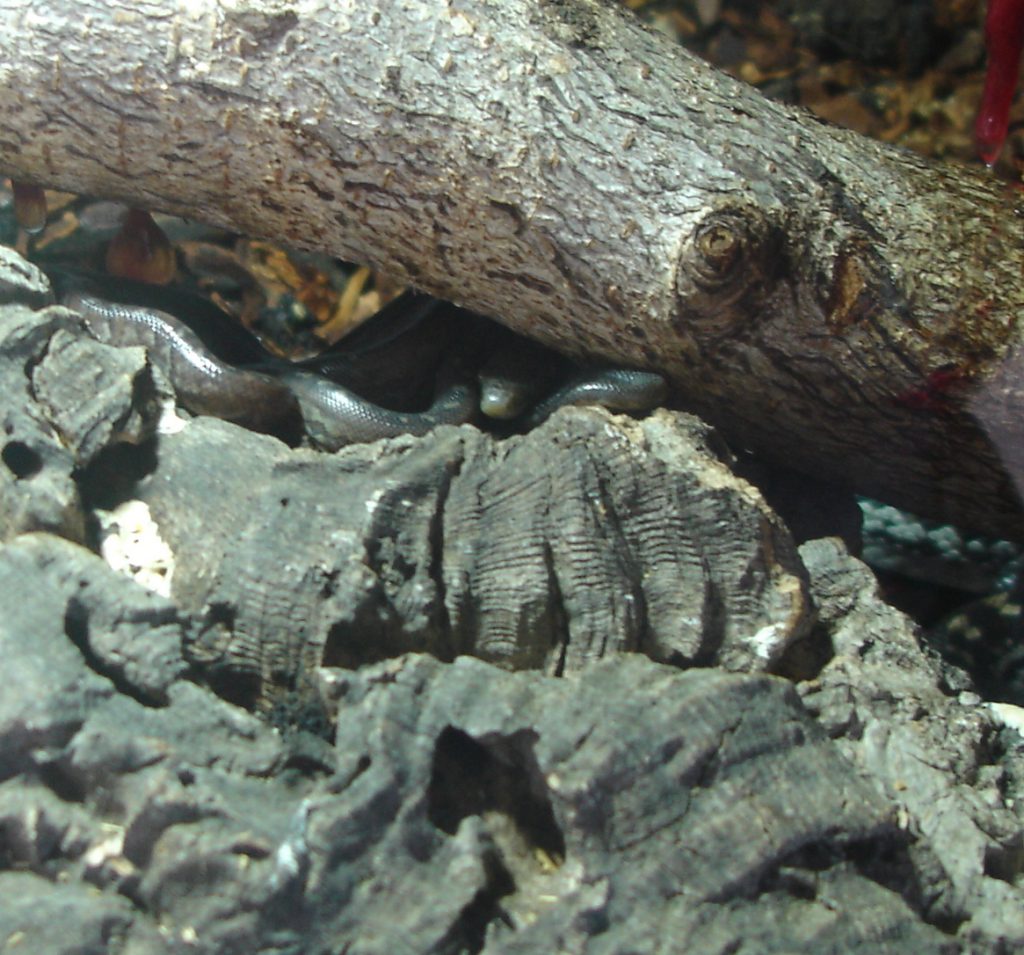
The litter contained 27 perfectly healthy babies. weighing between 12 and 16 grams. Average weight was 14.07 grams. The length of the babies is around 43 cm. The litter did not contain any unfertilized eggs, deformed or stillborn babies.
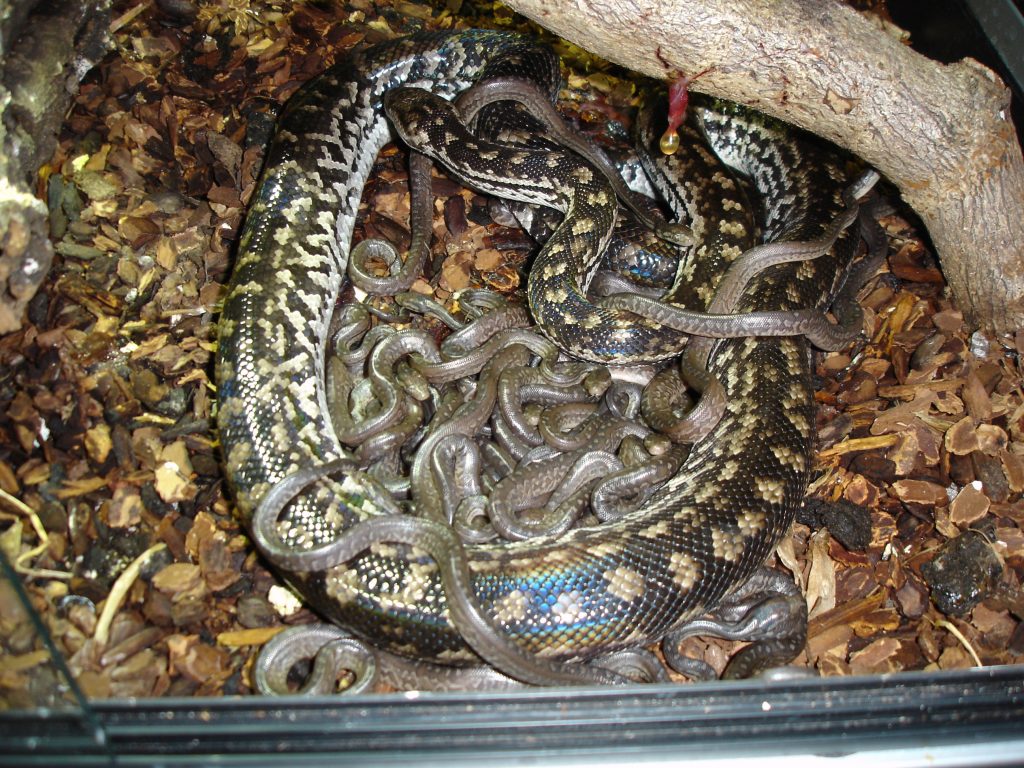
The relative clutch mass (RCM) indicates the amount of mass spent on the babies by their mother. The babies had a combined birth weight of 380 grams and the mother weighed post parturition 1087g. The RCM is calculated as: baby mass / (baby mass + mother mass post parturition). The mother spent 25.9% of her mass in babies, not accounting for fluids and extraembryonic tissue which could not be accurately weighed.
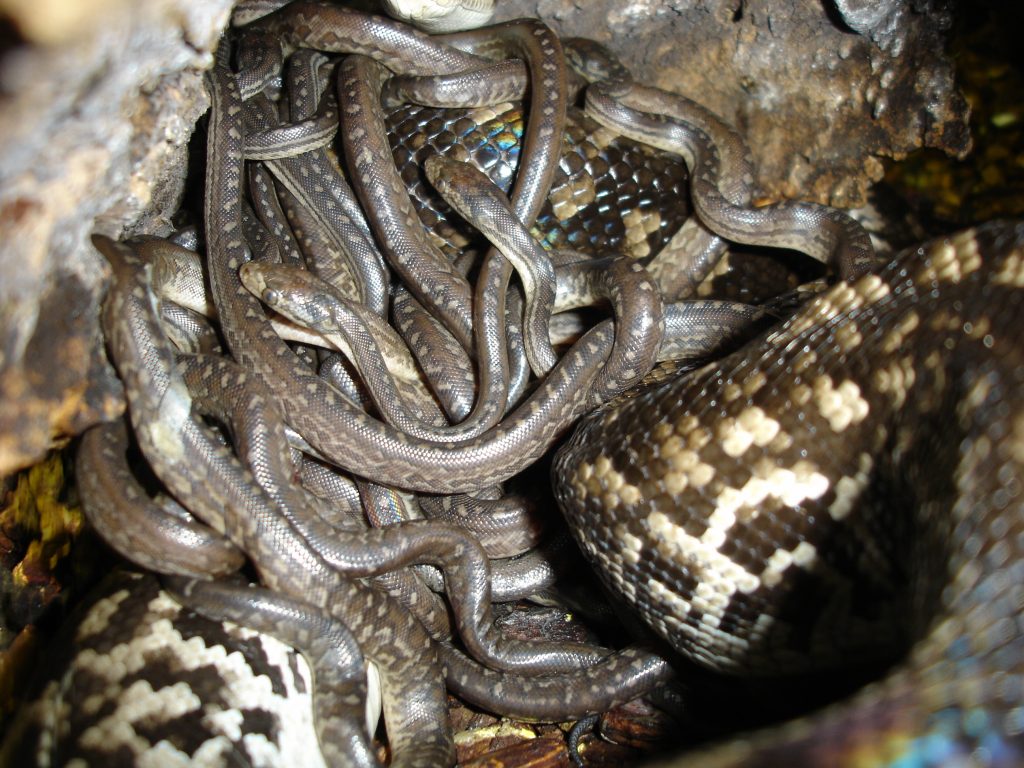
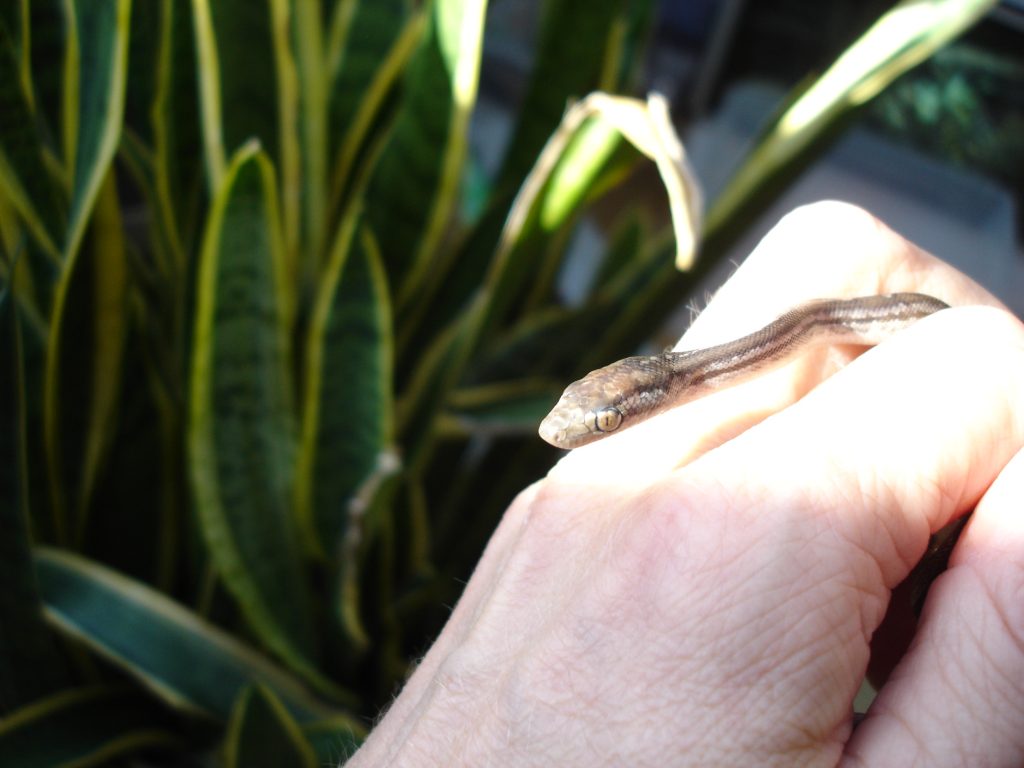
More information on the species can be found here.
Corallus cookii; documenting its life cycle in captivity
A small litter of Corallus cookii, born September 26 at approximately 10:00 p.m., consisted of six live neonates, three small unfertilized ovum and no stillborn. The neonates weighed 5.51 g to 14.09 g with an average weight of 11.86 g. The female moved away from the heat source immediately after shedding on 16 September. She also dropped a large quantity of pre-birth material in the bowel movement.
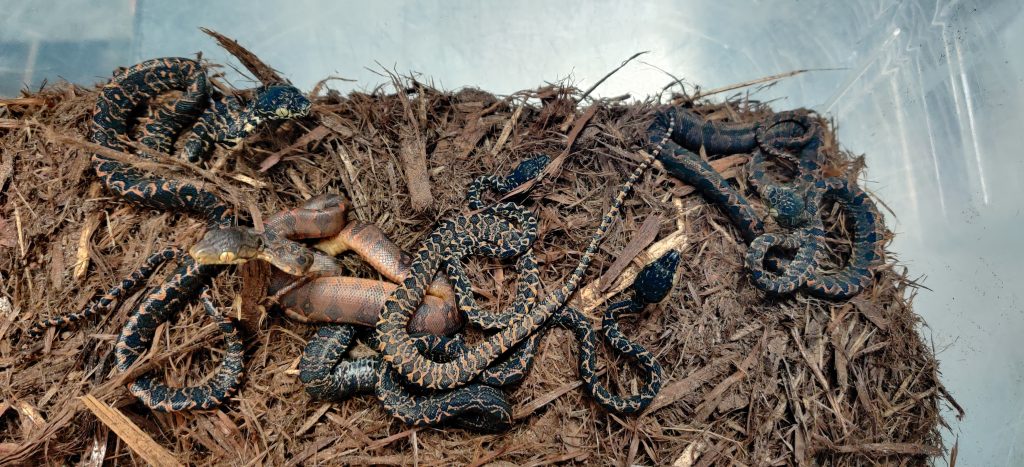
There is a variety of pattern and color between the neonates, though this polymorphism is not as pronounced as it is with C. hortunalus or C. grenadensis.
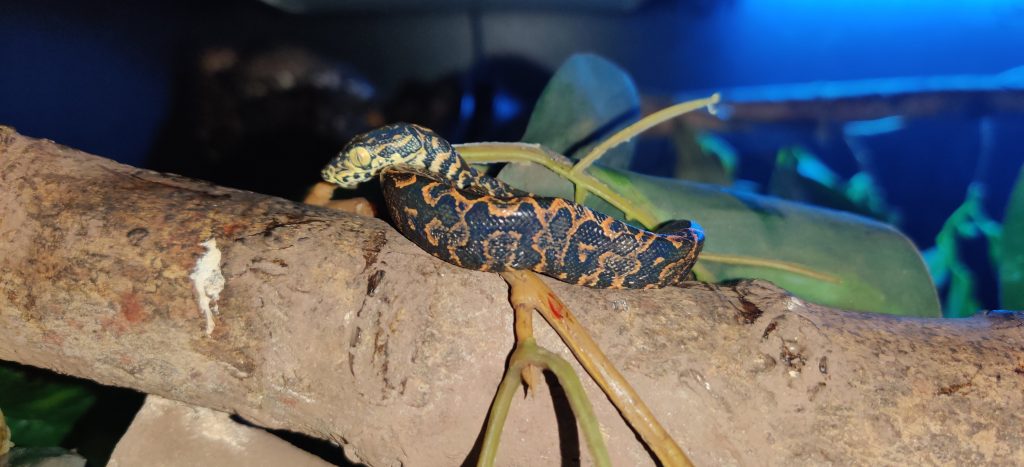
The female boa, once finished with parturition, consumed all three unfertilized ovum-possibly the first time this behavior has been documented in the species.
A total of three litters was produced in 2021:
- US: 6 live and 3 unfertilized ovum on 26 September. Smallest neonate weighed 5.51 g and the largest weighed 14 g with an average weight of 11.86 g.
- US: 5 live, 1 stillborn and 6 unfertilized ovum on 8 October. Smallest neonate weighed 7.96 g and the largest weighed 9.89 g with an average weight of 8.65 g.
- US: 5 live, 1 stillborn and 2 unfertilized ovum on 8 October. Smallest neonate weighed 7.4 g and the largest weighed 12.0 g with an average of 10.18 g.
For more photos and a complete overview of the species, view the C. cookii chapter.
Research News – Chilabothrus strigilatus
The Bahama Boa, Chilabothrus strigilatus, was first described in 1862. However, even almost 160 years after it’s first description, the ecology of this boa still holds many facts that are unknown to science.
The team of Sebastian Hoefer and colleagues were interested in several biological aspects of the snakes occurring on Eleuthera Island. In their recent study they investigated two snake species occurring on Eleuthera Island and compared prey as well as endoparasite prevalence in the snakes .
Eleuthera Island is one of several islands and cays where Chilabothrus strigilatus occurs. Eleuthera Island has a surface area of 457 km2, maximum elevation of 60 meters above sea level, is 120 km long and, in places, 1 km wide. Eleuthera Island is located on the eastern part of the Great Bahama Bank.
The study took place from 19 August 2019 to 16 March 2020. The researchers took the approach to collect road killed specimens of the snakes on Eleuthera and investigate stomach contents as well as parasite load. This approach is unique and offers detailed insights without sacrificing healthy snakes.
The team investigated across four habitat types and the road was investigated up to four times daily by car or bike. As a result, the researchers collected 270 road killed snakes representing all four species (232 Bahamian Racers, 31 Bahamian Boas, 6 Northern Bahamas Tropidophis, and 1 Cuban Brown Blindsnake) occurring across Eleuthera. During this seven-month period, road killed snakes amounted to 35.5 snakes per month or 1.2 a day. For Bahamian Boas, this translated to 5.2 road kills per month. Road mortality was previously studied on another Bahamian boa species, Chilabothrus exsul on Abaco Island . The study concluded that on Abaco island 1.6 Boas are lost per week due to road mortality. This amounts to a total of 83.2 Boas per year. The data of Hoefer and colleagues amounts to an annual loss of 62.4 boas. Thus road mortality and increased traffic poses a serious threat to at least two Bahamian boa species.
The main aim of the study however was the prey selection and parasite load. The Bahamian Racer Cubophis vudii vudii feeds predominantly on lizards (Anolis sp.). However, they found the Racers to be opportunistic generalists and in addition to documenting oophagy for the first time in any Bahamian snake, they also described two snakes, Tropidophis canus barbouri and Typhlops lumbricalis, as prey items of the Racer.
In contrast, the diet of Bahamian Boas consisted exclusively of of anoles and rats. Juvenile boas fed exclusively on anoles and adults consumed only rats. This finding confirms an ontogenetic shift in the feeding ecology of the Bahamian Boa.
Regarding the endoparasite load, it was interesting that nematodes were found in most of the racers but none of the boas. One explanation for this observation is that sample size was different in Boas and Racers but this could also be attributable to differences in activity, movement patterns and foraging behavior between the species.
More information on Bahamas boas can be found here.
Citations
The purpose of this work and its contents is to provide a public and permanent scientific record.
~ Jeff Murray & Michael Saina